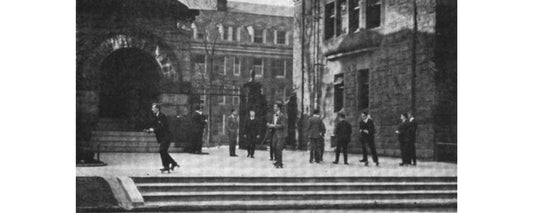I’m as likely to indulge in “golden age thinking” as any mortal, and I admit, I’ve always harbored a desire to time-travel to the early days of the New Haven Colony. I’d love to see that stern yet adventurous community, settled in 1638 by a group of Puritans who had split from England and again from Massachusetts Bay, establishing a relatively peaceful coexistence with the native Quinnipiacs.
Who couldn’t admire the populace that developed the first “planned” town in the United States, laid out in a grid of nine squares anchored by the New Haven Green? That established one of the fledgling country’s first grammar schools? Whose heirs would nurture the third-oldest institution of higher learning in the United States and establish America’s first public tree-planting program (which eventually earned their home the nickname “The Elm City”)?
According to The Case of the Piglet’s Paternity: Trials from the New Haven Colony, 1639-1663—written by former New Haven District Superior Court judge and current state referee Jon C. Blue—and the colony records from which it draws, one place I wouldn’t want to be in early New Haven was afoul of the law. The judicial system, helmed by a court of prominent citizens, was guided by a form of theocratic jurisprudence aligned with the colony’s Puritan faith. Blue describes most trials of the time as being held in a “hot” court, one in which the accused was expected to maintain innocence or admit guilt under a comparatively chaotic onslaught of accusations from witnesses and on-the-spot queries from judges.
Bestiality—a capital offense in Britain—appears to have been a particularly hot issue for the local legal system of the time. The earliest case Blue recounts, in 1642 (which gives the book its title), concerns the suspicious paternity of a dead piglet born to a sow belonging to farmer John Wakeman. In that unscientific time, the piglet was believed to bear an uncanny resemblance to a man named George Spencer—a servant of the man who sold the sow to Wakeman—thanks to the shared curse of a grossly deformed eye as well as other, humanoid features. Testimony from local witnesses convinced various authorities, including the colony’s minister, John Davenport, and governor, Theophilus Eaton, that Spencer had had carnal knowledge of the sow, and he was browbeaten into confessing the deed. Both he and the sow were sentenced to death by the biblical “rule of Leviticus,” with the sow being slaughtered in Spencer’s sight before he was publicly hanged.
Thirteen years later in Milford, which shared a jurisdiction with New Haven, a similar fate prevailed. Fifteen-year-old Walter Robinson was accused of “filthy acts upon the Lord’s day” with a “bitch” (female dog) while watching sheep. Though he claimed he was warned away from committing the act by a local bystander, both Robinson and the dog met the same fate as Wakeman and the sow, for engaging in “such horrible wickedness.”
Two years after that, an accused named John Ferris fared somewhat better. The witness, one Henry Accerly, claimed to see the act during a dark and rainy night in a corn field. The court determined that the testimony of only one witness precluded the passing of a death sentence. Still, to set a “terrifying” example to his community, he was severely whipped—twice—and fitted with a halter he must wear, Blue writes, “until the court saw cause to alter it.” He was also ordered to pay a fine and imprisoned pending a “second correction.” (There’s no word as to whether the cow survived this episode.)
Women, too, were subject to punishment, which the trial itself could constitute. One case highlighted in Piglet’s Paternity concerns three “women dissidents” in 1646: Mrs. Brewster, Mrs. Moore and Mrs. Leach, who were tried, as the colony records put it, for “severall miscarriadges of a publique nature”—basically, expressing offensive opinions and ideas. Outed by two former servants of Mrs. Leach—Elizabeth Smith and Job Hall—14 charges were made against Brewster alone, many of them rooted in Brewster’s alleged habit of making unacceptable remarks. These included: that a sermon of Davenport’s had made her sick and was fit to be used as “wast paper” (perhaps what we now call toilet paper); that Leach would be better off not joining the church; that the women, in light of their dissatisfactions, should leave New Haven for Rhode Island; that Smith was a “slutt” and a “harlott”; and that her son had said he’d “rather be hanged” than “fall into the<> hands” of local authorities.
Ultimately, after an exhaustive and contested inquiry into who said what and what they meant, the court decided the three should be censured but that the seriousness of their cases warranted referral to a higher, jurisdictional court of magistrates. Surviving records don’t say whether or not this actually happened, or, if it did, what sentence was passed. But they do state that, as the women’s trial came to a close, Mrs. Leach “offended the whole court” in part by speaking in a manner “vncomly for her sex & age.”
Which sounds like something I might have been accused of. So, after considering these cases of colonial justice, my interest in local time travel has been greatly dampened. As Carly Simon sang in “Anticipation,” I’ll “stay right here, for these are the good old days.” Or, at least, the best so far.
Written by Patricia Grandjean. Image, of the New Haven Museum’s photostat copy of New Haven Colony: Records of General Court (Volume 1, 1638-1649), photographed by Dan Mims.







